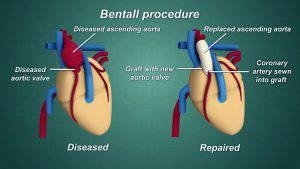What Is a Bentall Procedure and How Does It Work?

A Bentall procedure is a complex yet life-saving surgery designed to address aortic aneurysms, dissections, and damaged aortic valves. Named after its creator, Dr. Hugh Bentall, this procedure involves replacing the aortic root, aortic valve, and ascending aorta with a composite graft. By restoring normal blood flow and function to the heart, the procedure offers patients a chance at a healthier life.
This blog delves into the intricacies of the Bentall procedure, its steps, and how it works.
What Is a Bentall Procedure?
A Bentall procedure is a surgical technique used to treat aortic aneurysms that involve the aortic root, the section where the aorta connects to the heart, and the aortic valve. During the procedure, the surgeon replaces the damaged aortic valve and aortic root with a composite graft, which includes a mechanical or biological valve and a segment of the aorta.
Dr. Dinesh Mittalis, one of India’s leading cardiac surgeons, is renowned for his exceptional expertise in performing the Bentall procedure. His remarkable skill and precision in this complex surgery have resulted in successful outcomes for numerous patients, earning him widespread recognition.
How Does The Procedure Work?
The procedure functions through the following steps:
- Anesthesia and Incision: The surgery is performed under general anaesthesia. The surgeon makes an incision in the chest to access the heart and aorta.
- Aortic Valve and Aortic Root Removal: The damaged aortic valve and aortic root are carefully dissected and removed. This step is critical as it involves the removal of diseased tissue.
- Graft Implantation: A composite graft, which consists of a mechanical or biological valve and a segment of the aorta, is sewn into place. This graft replaces the removed aortic valve and aortic root.
- Reconnection: The other end of the graft is connected to the remaining aorta, ensuring proper blood flow from the heart to the rest of the body.
- Closure: The incision is closed, and the patient is monitored closely in the intensive care unit (ICU) during the initial recovery period.
What Are the Benefits of the Bentall Procedure?
The advantages of the procedure include:
- Improved Blood Flow: This procedure restores proper blood flow from the heart to the body by replacing the damaged aortic valve and aortic root.
- Prevention of Rupture: The procedure reduces the risk of a life-threatening rupture by removing the weakened section of the aorta and replacing it with a graft.
- Improved Quality of Life: Many patients experience improved heart function and quality of life following a successful Bentall procedure.
A happy patient of Dr Dinesh Mittal shared, “My experience with the Bentall procedure at Dr Dinesh’s hands was truly exceptional. From the initial consultation to the surgery and follow-up visits, Dr Dinesh and his team were professional, caring, and knowledgeable. I am grateful for their expertise and dedication, which have greatly improved my health and quality of life.”
How Much Does a Bentall Procedure Cost in India?
The cost of a Bentall procedure in India generally ranges from ₹8,00,000 to ₹15,00,000 (approximately $10,000 to $20,000). However, the Bentall procedure cost in India can be influenced by the following factors:
- Hospital Reputation: Renowned hospitals with advanced facilities may charge higher fees.
- Surgeon’s Experience: Surgeons with extensive experience and a high success rate may charge more.
- Medical Complications: Additional costs may arise if there are any complications during or after the procedure.
- Diagnostic Tests: Costs for pre-operative tests such as MRI, CT scans, and blood tests are additional.
- Hospital Stay: The duration of hospitalisation can affect the overall cost.
- Medication: Post-operative medication and follow-up costs are additional.
- Location: Hospitals in metropolitan cities may charge more than those in smaller towns.
- Miscellaneous Costs: These may include consultation fees, nursing charges, and other ancillary expenses.
Thus, it is advisable to consult with a healthcare provider for an accurate estimate based on individual circumstances.
Conclusion
Bentall procedure is a highly effective surgical technique for treating aortic aneurysms and conditions affecting the aortic valve. It offers patients a chance to improve their quality of life and reduce the risk of life-threatening complications associated with aortic aneurysms. If you or a loved one are facing aortic surgery, it’s essential to discuss all treatment options with your healthcare provider to determine the best course of action.
FAQs
-
How long does the Bentall procedure take to perform?
The procedure typically takes around four to six hours to complete.
-
What is the recovery time after a Bentall procedure?
The recovery time varies from patient to patient but generally ranges from four to six weeks.
-
Is the Bentall procedure a major surgery?
Yes, the Bentall procedure is a major surgery that requires general anaesthesia and careful post-operative care.
-
Are there any risks or complications associated with the Bentall procedure?
Like any surgery, the Bentall procedure carries risks such as bleeding, infection, and adverse reactions to anaesthesia. However, these risks are generally low in experienced hands.
-
Can the Bentall procedure be performed on children or adolescents?
Yes, the Bentall procedure can be performed on children and adolescents with specific congenital heart conditions that necessitate aortic root and valve replacement.
Explore more blogs: Can Biventricular Pacemaker Implantation Improve Heart Function?
